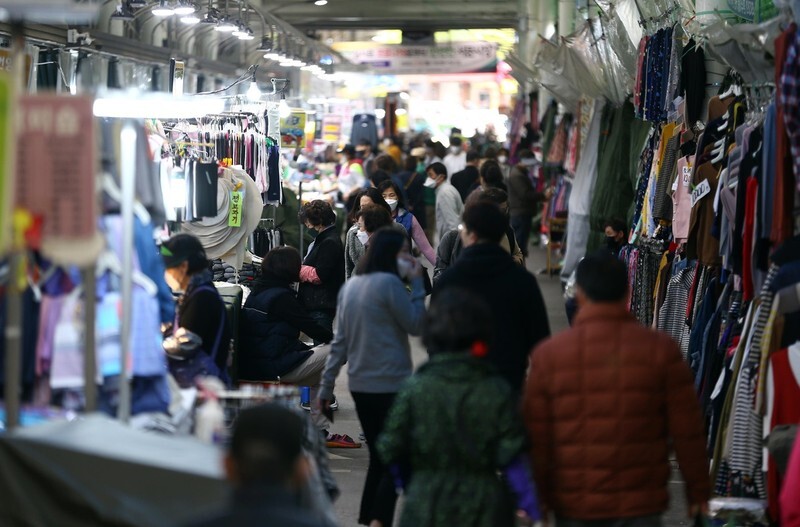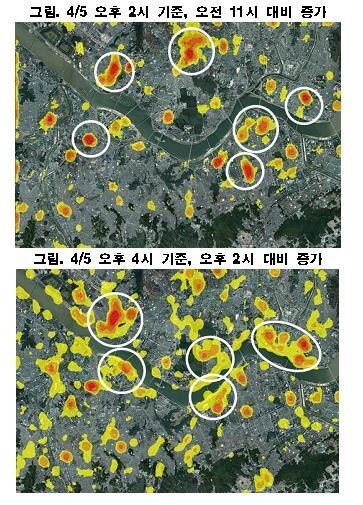hankyoreh
Links to other country sites 다른 나라 사이트 링크
S. Korea sees number of new COVID-19 fall below 50 in 46 days

South Korea reported 47 new cases of COVID-19 on Apr. 6, the first time in 46 days that the number fell below 50. But the country’s public health authorities called on the public to participate even more actively in social distancing measures, insisting that it’s too soon to relax. Since people were actually more active and mobile during the first round of intense social distancing (Mar. 22-Apr. 5) than they’d been before, the government is looking into additional measures, such as helping churches move their services online.
“While the number of new cases dipped below 50, that’s largely because fewer tests are conducted on the weekend: 6,000 compared to over 10,000 on weekdays. That figure doesn’t mean we’ve reached the stage where we can relax,” a spokesperson for South Korea’s Central Disaster and Safety Countermeasures Headquarters said on Monday.
“There’s still a risk that cases imported from overseas could spread. The fact that we’re not able to do contact tracing for 5-10% of patients means there are infected people in communities that the public health officials haven’t been able to identify. This is a grave situation where the explosive level of community-based infection that we’ve seen in Europe and the US could happen at any time in South Korea as well.”
The public health authorities announced another goal on Monday: bringing COVID-19’s reproduction number — that is, the average number of people who catch the disease from an infected individual — below one.
The reason the authorities remain on alert is because public movement actually increased during the first period of intense social distancing, up 30% from late February. This past weekend alone, the number of people taking public transit rose by about 500,000.
Visual data about Seoul’s transient population released by the disaster safety headquarters on Monday showed a surge of visitors on Apr. 4 to commercial districts popular with young people, such as Myeongdong, Gangnam, and Hongdae, and good places for viewing the spring flowers, such as Yeouido, the banks of the Han River, and the area around Namsan, the mountain in central Seoul. There were 1,914 churches holding on-site services in Seoul on Sunday, about a hundred more than the week before (1,817). Seoul believes that more churches are reopening as Easter approaches on Apr. 12.
Government to boost punishments for establishments that violate social distancing measures
This has led the government to look into ways to boost the efficacy of social distancing, such as providing support for online services and forcing the closure of facilities that violate quarantine regulations. The authorities have promised to boost monitoring and respond to violations by nightlife establishments and other businesses catering to the public by taking administrative actions, with punishment for repeat offenders.
Experts stress that being outside doesn’t provide surefire protection from the coronavirus. Kim Woo-ju, a professor of infectious disease at Korea University Guro Hospital, pointed to a measles outbreak at Disneyland in California in 2015. “When people are infected outside, it’s even harder to do contact tracing. New cases can occur at any time, not only at churches and hospitals but also in other locations. That’s why we need to take stern administrative action against offending facilities,” Kim said.
“There’s only so much we can do through punishment and sanctions. Our only choice is solidarity, the commitment to protecting both ourselves and other people,” said Kam Sin, professor of preventive medicine at Kyungpook National University Hospital.
By Park Da-hae, Noh Ji-won, and Chae Yoon-tae, staff reporters
Please direct comments or questions to [english@hani.co.kr]

Editorial・opinion
![[Column] Season 2 of special prosecutor probe may be coming to Korea soon [Column] Season 2 of special prosecutor probe may be coming to Korea soon](https://flexible.img.hani.co.kr/flexible/normal/500/300/imgdb/original/2024/0426/3317141030699447.jpg) [Column] Season 2 of special prosecutor probe may be coming to Korea soon
[Column] Season 2 of special prosecutor probe may be coming to Korea soon![[Column] Park Geun-hye déjà vu in Yoon Suk-yeol [Column] Park Geun-hye déjà vu in Yoon Suk-yeol](https://flexible.img.hani.co.kr/flexible/normal/500/300/imgdb/original/2024/0424/651713945113788.jpg) [Column] Park Geun-hye déjà vu in Yoon Suk-yeol
[Column] Park Geun-hye déjà vu in Yoon Suk-yeol- [Editorial] New weight of N. Korea’s nuclear threats makes dialogue all the more urgent
- [Guest essay] The real reason Korea’s new right wants to dub Rhee a founding father
- [Column] ‘Choson’: Is it time we start referring to N. Korea in its own terms?
- [Editorial] Japan’s rewriting of history with Korea has gone too far
- [Column] The president’s questionable capacity for dialogue
- [Column] Are chaebol firms just pizza pies for families to divvy up as they please?
- [Column] Has Korea, too, crossed the Rubicon on China?
- [Correspondent’s column] In Japan’s alliance with US, echoes of its past alliances with UK
Most viewed articles
- 1AI is catching up with humans at a ‘shocking’ rate
- 2Korea’s 1.3% growth in Q1 signals ‘textbook’ return to growth, says government
- 3[Column] Park Geun-hye déjà vu in Yoon Suk-yeol
- 4No good, very bad game for Korea puts it out of Olympics for first time since 1988
- 5[Column] Season 2 of special prosecutor probe may be coming to Korea soon
- 6[Column] Has Korea, too, crossed the Rubicon on China?
- 7Division commander ordered troops to enter raging flood waters before Marine died, survivor says
- 8Is Japan about to snatch control of Line messenger from Korea’s Naver?
- 9Marriages nosedived 40% over last 10 years in Korea, a factor in low birth rate
- 101 in 5 unwed Korean women want child-free life, study shows